Ảnh hưởng của tuổi đến sự biến đổi các tính chất vật lý và cơ học của gỗ keo tai tượng (Acacia mangium) trồng tại Thái Nguyên
Nghiên cứu này nhằm điều tra ảnh hưởng của tuổi đến một số tính
chất vật lý và cơ học của gỗ Keo tai tượng trồng tại Thái Nguyên
như: khối lượng thể tích (AD), độ bền uốn tĩnh (MOR), và mô đun
đàn hồi uốn tĩnh (MOE). Các mẫu gỗ có kích thước 20 (xuyên tâm)
× 20 (tiếp tuyến) × 320 (dọc thớ) mm được cắt từ vị trí ngang ngực
của các cây mẫu ở tuổi 7, 10, và 14. Kết quả nghiên cứu đã chỉ ra
rằng: giá trị trung bình AD ở độ ẩm 12% của Keo tai tượng tuổi 7,
10, và 14 lần lượt là 0,48 g/cm3, 0,51 g/cm3, và 0,53 g/cm3. Giá trị
trung bình MOR của gỗ Keo tai tượng tuổi 7, 10, và 14 lần lượt là
64,38 MPa, 71,59 MPa, và 73,46 MPa, trong khi đó giá trị MOE lần
lượt là 7,31 GPa, 8,77 GPa, và 9,10 GPa. AD có mối tương quan
dương rõ ràng với các tính chất cơ học ở tất cả các tuổi trong nghiên
cứu này. Điều này gợi ý rằng AD có thể là một thông số hữu ích để
dự đoán được các tính chất cơ học của gỗ Keo tai tượng trồng tại
Thái Nguyên. Cả AD, MOR, và MOE đã tăng lên đáng kể từ tuổi 7
đến tuổi 10 nhưng sau đó tăng chậm dần và có xu hướng không thay
đổi đến tuổi 14. Kết quả của nghiên cứu này là tài liệu tham khảo
quan trọng cho người trồng rừng Keo tai tượng khi quyết định có nên
kéo dài thời gian trồng sau 10 năm hay không.
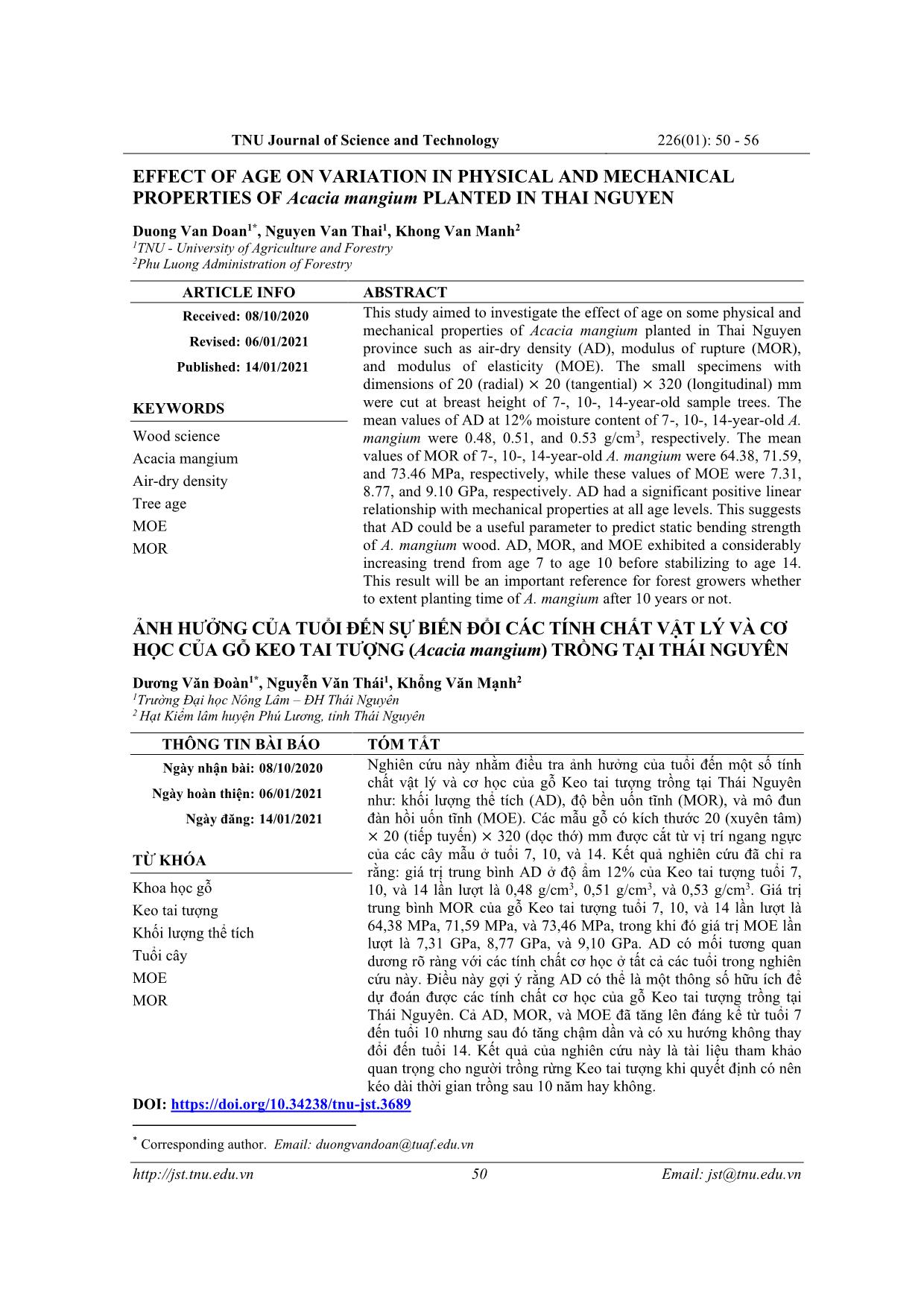
Trang 1
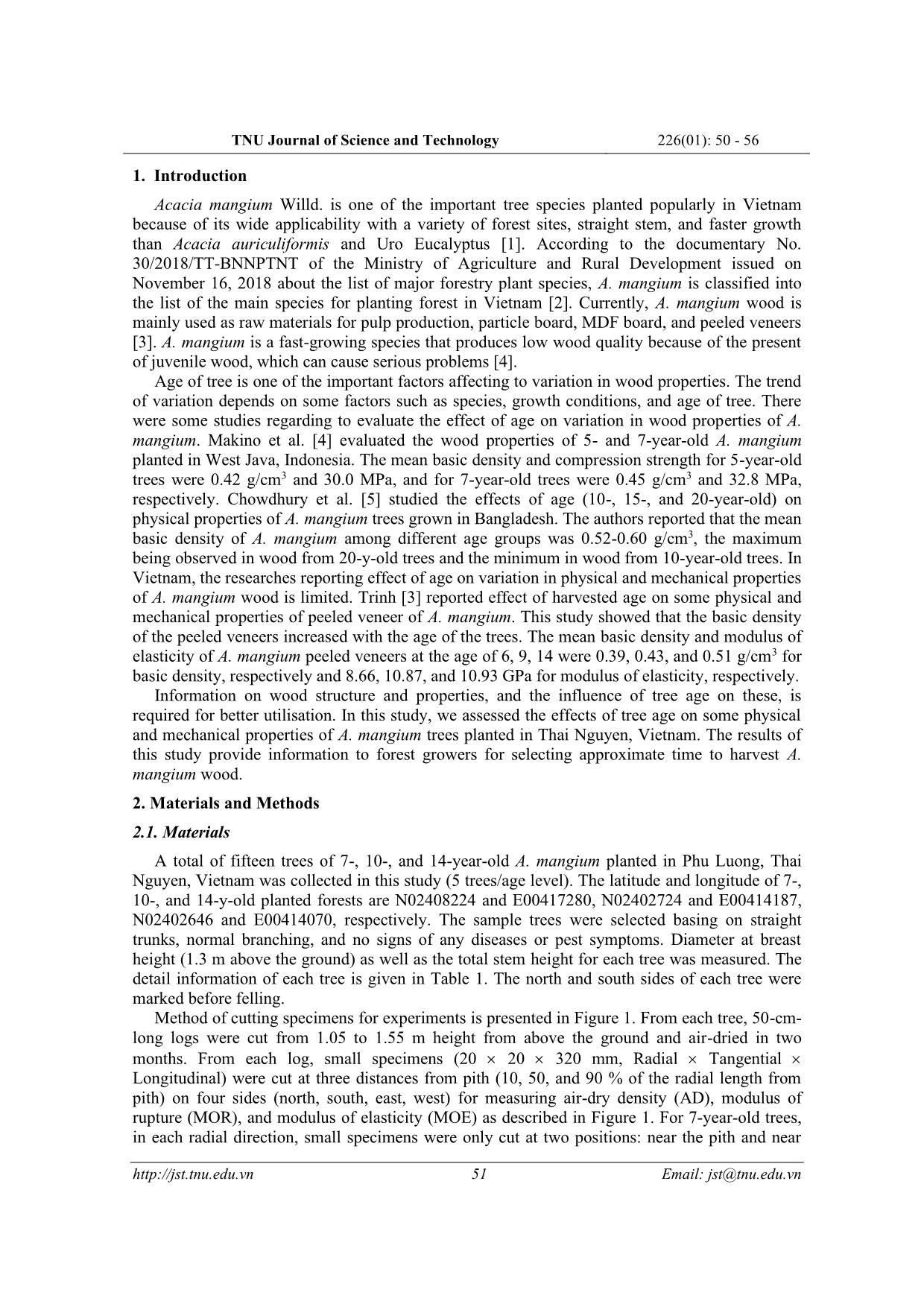
Trang 2
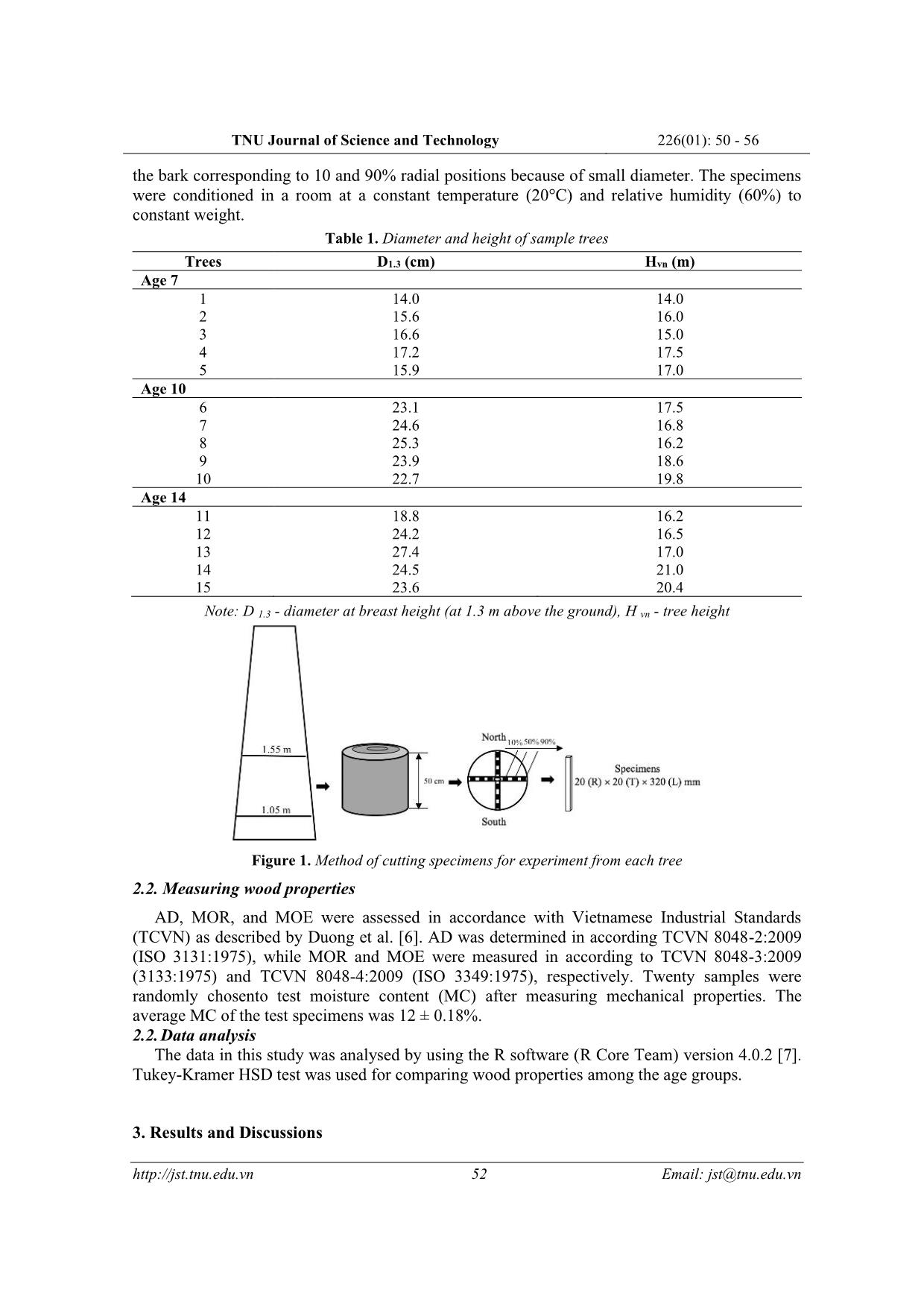
Trang 3
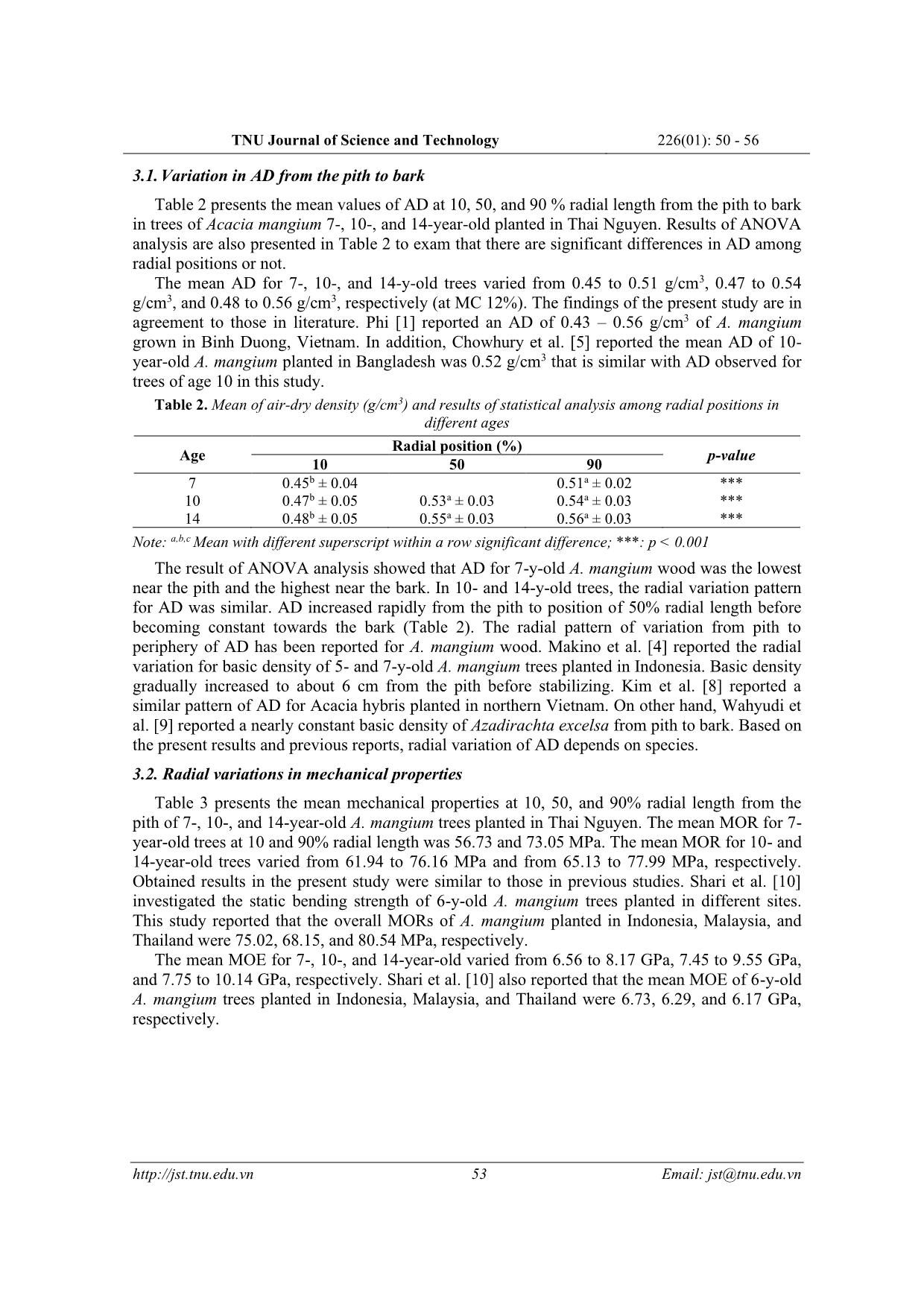
Trang 4
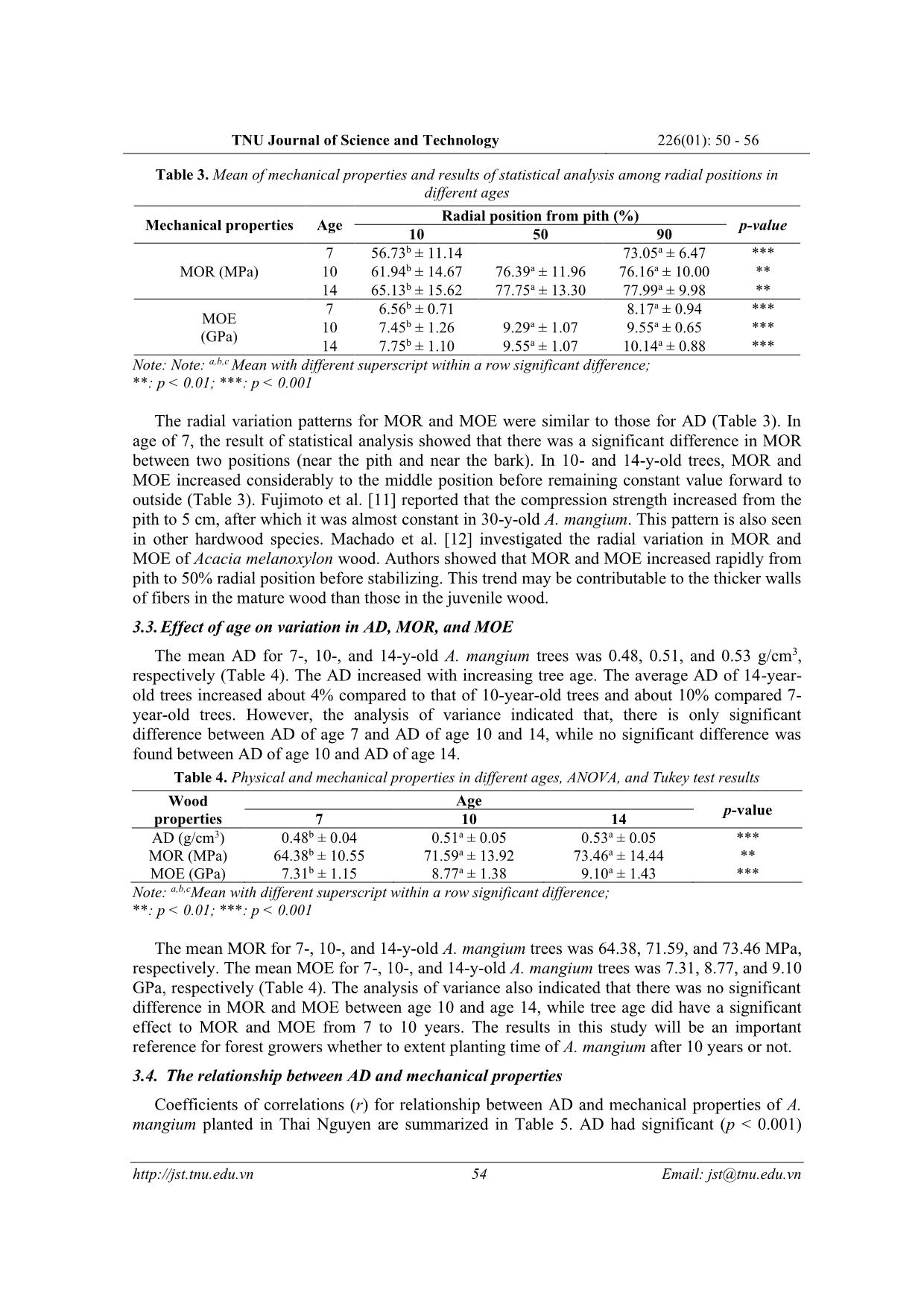
Trang 5
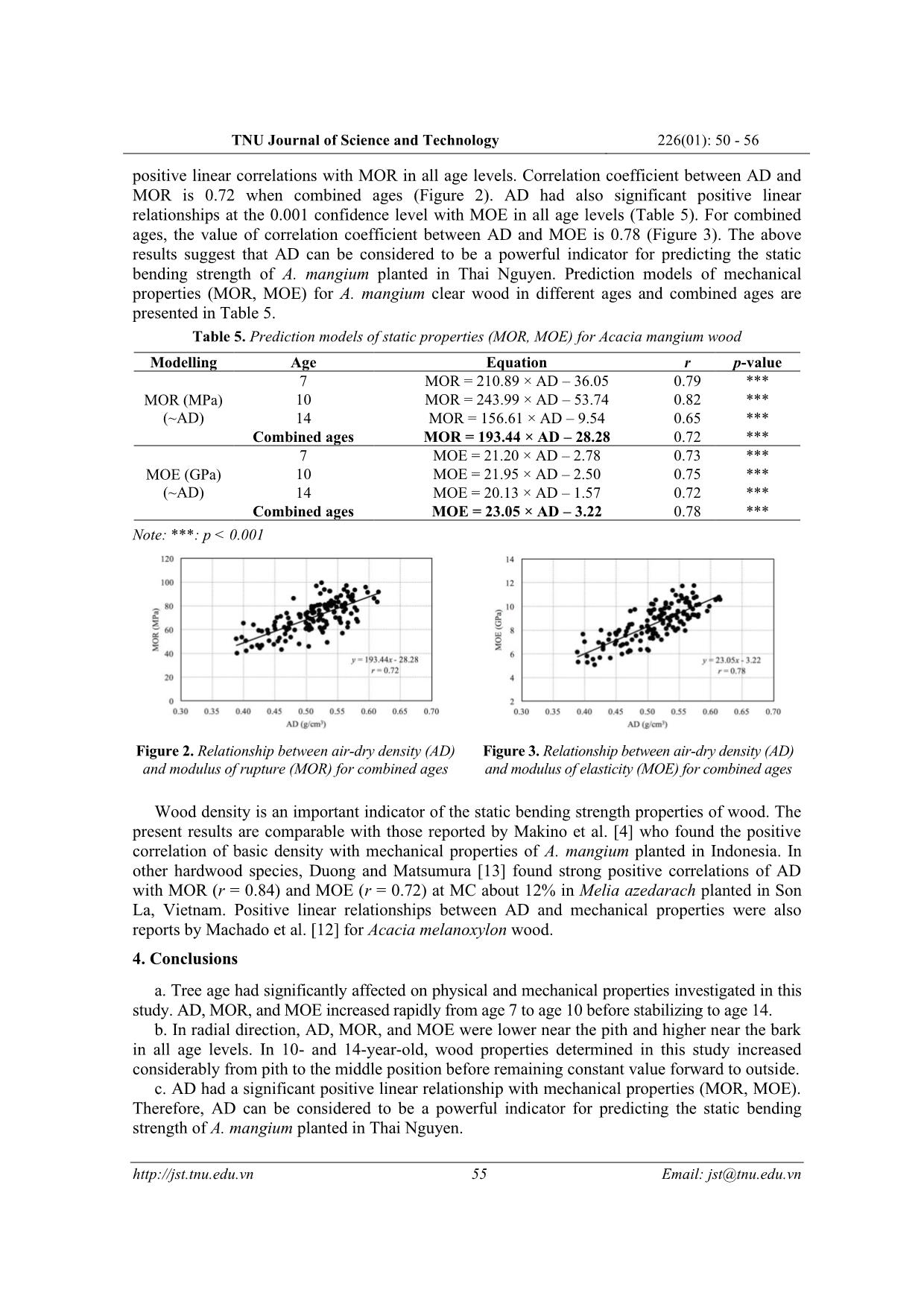
Trang 6
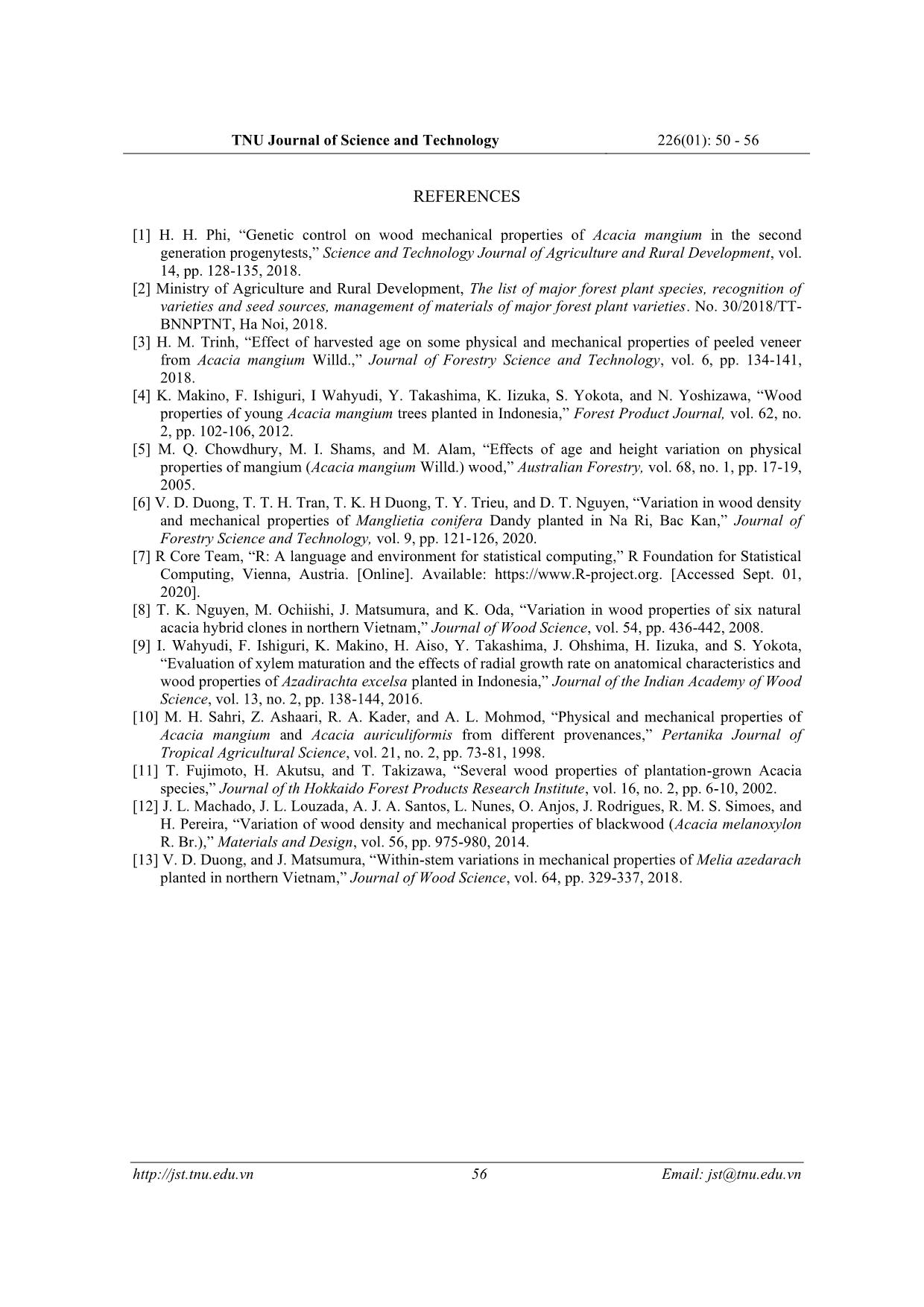
Trang 7
Tóm tắt nội dung tài liệu: Ảnh hưởng của tuổi đến sự biến đổi các tính chất vật lý và cơ học của gỗ keo tai tượng (Acacia mangium) trồng tại Thái Nguyên
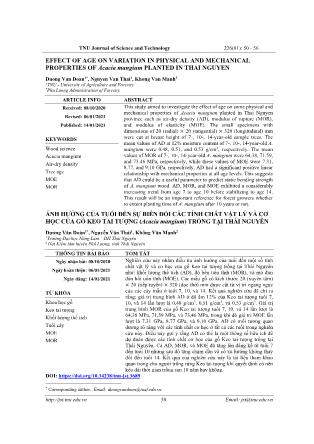
round and air-dried in two months. From each log, small specimens (20 20 320 mm, Radial Tangential Longitudinal) were cut at three distances from pith (10, 50, and 90 % of the radial length from pith) on four sides (north, south, east, west) for measuring air-dry density (AD), modulus of rupture (MOR), and modulus of elasticity (MOE) as described in Figure 1. For 7-year-old trees, in each radial direction, small specimens were only cut at two positions: near the pith and near 51 Email: jst@tnu.edu.vn TNU Journal of Science and Technology 226(01): 50 - 56 the bark corresponding to 10 and 90% radial positions because of small diameter. The specimens were conditioned in a room at a constant temperature (20°C) and relative humidity (60%) to constant weight. Table 1. Diameter and height of sample trees Trees D1.3 (cm) Hvn (m) Age 7 1 14.0 14.0 2 15.6 16.0 3 16.6 15.0 4 17.2 17.5 5 15.9 17.0 Age 10 6 23.1 17.5 7 24.6 16.8 8 25.3 16.2 9 23.9 18.6 10 22.7 19.8 Age 14 11 18.8 16.2 12 24.2 16.5 13 27.4 17.0 14 24.5 21.0 15 23.6 20.4 Note: D 1.3 - diameter at breast height (at 1.3 m above the ground), H vn - tree height Figure 1. Method of cutting specimens for experiment from each tree 2.2. Measuring wood properties AD, MOR, and MOE were assessed in accordance with Vietnamese Industrial Standards (TCVN) as described by Duong et al. [6]. AD was determined in according TCVN 8048-2:2009 (ISO 3131:1975), while MOR and MOE were measured in according to TCVN 8048-3:2009 (3133:1975) and TCVN 8048-4:2009 (ISO 3349:1975), respectively. Twenty samples were randomly chosento test moisture content (MC) after measuring mechanical properties. The average MC of the test specimens was 12 ± 0.18%. 2.2. Data analysis The data in this study was analysed by using the R software (R Core Team) version 4.0.2 [7]. Tukey-Kramer HSD test was used for comparing wood properties among the age groups. 3. Results and Discussions 52 Email: jst@tnu.edu.vn TNU Journal of Science and Technology 226(01): 50 - 56 3.1. Variation in AD from the pith to bark Table 2 presents the mean values of AD at 10, 50, and 90 % radial length from the pith to bark in trees of Acacia mangium 7-, 10-, and 14-year-old planted in Thai Nguyen. Results of ANOVA analysis are also presented in Table 2 to exam that there are significant differences in AD among radial positions or not. The mean AD for 7-, 10-, and 14-y-old trees varied from 0.45 to 0.51 g/cm3, 0.47 to 0.54 g/cm3, and 0.48 to 0.56 g/cm3, respectively (at MC 12%). The findings of the present study are in agreement to those in literature. Phi [1] reported an AD of 0.43 – 0.56 g/cm3 of A. mangium grown in Binh Duong, Vietnam. In addition, Chowhury et al. [5] reported the mean AD of 10- year-old A. mangium planted in Bangladesh was 0.52 g/cm3 that is similar with AD observed for trees of age 10 in this study. Table 2. Mean of air-dry density (g/cm3) and results of statistical analysis among radial positions in different ages Radial position (%) Age p-value 10 50 90 7 0.45b ± 0.04 0.51a ± 0.02 *** 10 0.47b ± 0.05 0.53a ± 0.03 0.54a ± 0.03 *** 14 0.48b ± 0.05 0.55a ± 0.03 0.56a ± 0.03 *** Note: a,b,c Mean with different superscript within a row significant difference; ***: p < 0.001 The result of ANOVA analysis showed that AD for 7-y-old A. mangium wood was the lowest near the pith and the highest near the bark. In 10- and 14-y-old trees, the radial variation pattern for AD was similar. AD increased rapidly from the pith to position of 50% radial length before becoming constant towards the bark (Table 2). The radial pattern of variation from pith to periphery of AD has been reported for A. mangium wood. Makino et al. [4] reported the radial variation for basic density of 5- and 7-y-old A. mangium trees planted in Indonesia. Basic density gradually increased to about 6 cm from the pith before stabilizing. Kim et al. [8] reported a similar pattern of AD for Acacia hybris planted in northern Vietnam. On other hand, Wahyudi et al. [9] reported a nearly constant basic density of Azadirachta excelsa from pith to bark. Based on the present results and previous reports, radial variation of AD depends on species. 3.2. Radial variations in mechanical properties Table 3 presents the mean mechanical properties at 10, 50, and 90% radial length from the pith of 7-, 10-, and 14-year-old A. mangium trees planted in Thai Nguyen. The mean MOR for 7- year-old trees at 10 and 90% radial length was 56.73 and 73.05 MPa. The mean MOR for 10- and 14-year-old trees varied from 61.94 to 76.16 MPa and from 65.13 to 77.99 MPa, respectively. Obtained results in the present study were similar to those in previous studies. Shari et al. [10] investigated the static bending strength of 6-y-old A. mangium trees planted in different sites. This study reported that the overall MORs of A. mangium planted in Indonesia, Malaysia, and Thailand were 75.02, 68.15, and 80.54 MPa, respectively. The mean MOE for 7-, 10-, and 14-year-old varied from 6.56 to 8.17 GPa, 7.45 to 9.55 GPa, and 7.75 to 10.14 GPa, respectively. Shari et al. [10] also reported that the mean MOE of 6-y-old A. mangium trees planted in Indonesia, Malaysia, and Thailand were 6.73, 6.29, and 6.17 GPa, respectively. 53 Email: jst@tnu.edu.vn TNU Journal of Science and Technology 226(01): 50 - 56 Table 3. Mean of mechanical properties and results of statistical analysis among radial positions in different ages Radial position from pith (%) Mechanical properties Age p-value 10 50 90 7 56.73b ± 11.14 73.05a ± 6.47 *** MOR (MPa) 10 61.94b ± 14.67 76.39a ± 11.96 76.16a ± 10.00 ** 14 65.13b ± 15.62 77.75a ± 13.30 77.99a ± 9.98 ** 7 6.56b ± 0.71 8.17a ± 0.94 *** MOE 10 7.45b ± 1.26 9.29a ± 1.07 9.55a ± 0.65 *** (GPa) 14 7.75b ± 1.10 9.55a ± 1.07 10.14a ± 0.88 *** Note: Note: a,b,c Mean with different superscript within a row significant difference; **: p < 0.01; ***: p < 0.001 The radial variation patterns for MOR and MOE were similar to those for AD (Table 3). In age of 7, the result of statistical analysis showed that there was a significant difference in MOR between two positions (near the pith and near the bark). In 10- and 14-y-old trees, MOR and MOE increased considerably to the middle position before remaining constant value forward to outside (Table 3). Fujimoto et al. [11] reported that the compression strength increased from the pith to 5 cm, after which it was almost constant in 30-y-old A. mangium. This pattern is also seen in other hardwood species. Machado et al. [12] investigated the radial variation in MOR and MOE of Acacia melanoxylon wood. Authors showed that MOR and MOE increased rapidly from pith to 50% radial position before stabilizing. This trend may be contributable to the thicker walls of fibers in the mature wood than those in the juvenile wood. 3.3. Effect of age on variation in AD, MOR, and MOE The mean AD for 7-, 10-, and 14-y-old A. mangium trees was 0.48, 0.51, and 0.53 g/cm3, respectively (Table 4). The AD increased with increasing tree age. The average AD of 14-year- old trees increased about 4% compared to that of 10-year-old trees and about 10% compared 7- year-old trees. However, the analysis of variance indicated that, there is only significant difference between AD of age 7 and AD of age 10 and 14, while no significant difference was found between AD of age 10 and AD of age 14. Table 4. Physical and mechanical properties in different ages, ANOVA, and Tukey test results Wood Age p-value properties 7 10 14 AD (g/cm3) 0.48b ± 0.04 0.51a ± 0.05 0.53a ± 0.05 *** MOR (MPa) 64.38b ± 10.55 71.59a ± 13.92 73.46a ± 14.44 ** MOE (GPa) 7.31b ± 1.15 8.77a ± 1.38 9.10a ± 1.43 *** Note: a,b,cMean with different superscript within a row significant difference; **: p < 0.01; ***: p < 0.001 The mean MOR for 7-, 10-, and 14-y-old A. mangium trees was 64.38, 71.59, and 73.46 MPa, respectively. The mean MOE for 7-, 10-, and 14-y-old A. mangium trees was 7.31, 8.77, and 9.10 GPa, respectively (Table 4). The analysis of variance also indicated that there was no significant difference in MOR and MOE between age 10 and age 14, while tree age did have a significant effect to MOR and MOE from 7 to 10 years. The results in this study will be an important reference for forest growers whether to extent planting time of A. mangium after 10 years or not. 3.4. The relationship between AD and mechanical properties Coefficients of correlations (r) for relationship between AD and mechanical properties of A. mangium planted in Thai Nguyen are summarized in Table 5. AD had significant (p < 0.001) 54 Email: jst@tnu.edu.vn TNU Journal of Science and Technology 226(01): 50 - 56 positive linear correlations with MOR in all age levels. Correlation coefficient between AD and MOR is 0.72 when combined ages (Figure 2). AD had also significant positive linear relationships at the 0.001 confidence level with MOE in all age levels (Table 5). For combined ages, the value of correlation coefficient between AD and MOE is 0.78 (Figure 3). The above results suggest that AD can be considered to be a powerful indicator for predicting the static bending strength of A. mangium planted in Thai Nguyen. Prediction models of mechanical properties (MOR, MOE) for A. mangium clear wood in different ages and combined ages are presented in Table 5. Table 5. Prediction models of static properties (MOR, MOE) for Acacia mangium wood Modelling Age Equation r p-value 7 MOR = 210.89 × AD – 36.05 0.79 *** MOR (MPa) 10 MOR = 243.99 × AD – 53.74 0.82 *** (~AD) 14 MOR = 156.61 × AD – 9.54 0.65 *** Combined ages MOR = 193.44 × AD – 28.28 0.72 *** 7 MOE = 21.20 × AD – 2.78 0.73 *** MOE (GPa) 10 MOE = 21.95 × AD – 2.50 0.75 *** (~AD) 14 MOE = 20.13 × AD – 1.57 0.72 *** Combined ages MOE = 23.05 × AD – 3.22 0.78 *** Note: ***: p < 0.001 Figure 2. Relationship between air-dry density (AD) Figure 3. Relationship between air-dry density (AD) and modulus of rupture (MOR) for combined ages and modulus of elasticity (MOE) for combined ages Wood density is an important indicator of the static bending strength properties of wood. The present results are comparable with those reported by Makino et al. [4] who found the positive correlation of basic density with mechanical properties of A. mangium planted in Indonesia. In other hardwood species, Duong and Matsumura [13] found strong positive correlations of AD with MOR (r = 0.84) and MOE (r = 0.72) at MC about 12% in Melia azedarach planted in Son La, Vietnam. Positive linear relationships between AD and mechanical properties were also reports by Machado et al. [12] for Acacia melanoxylon wood. 4. Conclusions a. Tree age had significantly affected on physical and mechanical properties investigated in this study. AD, MOR, and MOE increased rapidly from age 7 to age 10 before stabilizing to age 14. b. In radial direction, AD, MOR, and MOE were lower near the pith and higher near the bark in all age levels. In 10- and 14-year-old, wood properties determined in this study increased considerably from pith to the middle position before remaining constant value forward to outside. c. AD had a significant positive linear relationship with mechanical properties (MOR, MOE). Therefore, AD can be considered to be a powerful indicator for predicting the static bending strength of A. mangium planted in Thai Nguyen. 55 Email: jst@tnu.edu.vn TNU Journal of Science and Technology 226(01): 50 - 56 REFERENCES [1] H. H. Phi, “Genetic control on wood mechanical properties of Acacia mangium in the second generation progenytests,” Science and Technology Journal of Agriculture and Rural Development, vol. 14, pp. 128-135, 2018. [2] Ministry of Agriculture and Rural Development, The list of major forest plant species, recognition of varieties and seed sources, management of materials of major forest plant varieties. No. 30/2018/TT- BNNPTNT, Ha Noi, 2018. [3] H. M. Trinh, “Effect of harvested age on some physical and mechanical properties of peeled veneer from Acacia mangium Willd.,” Journal of Forestry Science and Technology, vol. 6, pp. 134-141, 2018. [4] K. Makino, F. Ishiguri, I Wahyudi, Y. Takashima, K. Iizuka, S. Yokota, and N. Yoshizawa, “Wood properties of young Acacia mangium trees planted in Indonesia,” Forest Product Journal, vol. 62, no. 2, pp. 102-106, 2012. [5] M. Q. Chowdhury, M. I. Shams, and M. Alam, “Effects of age and height variation on physical properties of mangium (Acacia mangium Willd.) wood,” Australian Forestry, vol. 68, no. 1, pp. 17-19, 2005. [6] V. D. Duong, T. T. H. Tran, T. K. H Duong, T. Y. Trieu, and D. T. Nguyen, “Variation in wood density and mechanical properties of Manglietia conifera Dandy planted in Na Ri, Bac Kan,” Journal of Forestry Science and Technology, vol. 9, pp. 121-126, 2020. [7] R Core Team, “R: A language and environment for statistical computing,” R Foundation for Statistical Computing, Vienna, Austria. [Online]. Available: https://www.R-project.org. [Accessed Sept. 01, 2020]. [8] T. K. Nguyen, M. Ochiishi, J. Matsumura, and K. Oda, “Variation in wood properties of six natural acacia hybrid clones in northern Vietnam,” Journal of Wood Science, vol. 54, pp. 436-442, 2008. [9] I. Wahyudi, F. Ishiguri, K. Makino, H. Aiso, Y. Takashima, J. Ohshima, H. Iizuka, and S. Yokota, “Evaluation of xylem maturation and the effects of radial growth rate on anatomical characteristics and wood properties of Azadirachta excelsa planted in Indonesia,” Journal of the Indian Academy of Wood Science, vol. 13, no. 2, pp. 138-144, 2016. [10] M. H. Sahri, Z. Ashaari, R. A. Kader, and A. L. Mohmod, “Physical and mechanical properties of Acacia mangium and Acacia auriculiformis from different provenances,” Pertanika Journal of Tropical Agricultural Science, vol. 21, no. 2, pp. 73-81, 1998. [11] T. Fujimoto, H. Akutsu, and T. Takizawa, “Several wood properties of plantation-grown Acacia species,” Journal of th Hokkaido Forest Products Research Institute, vol. 16, no. 2, pp. 6-10, 2002. [12] J. L. Machado, J. L. Louzada, A. J. A. Santos, L. Nunes, O. Anjos, J. Rodrigues, R. M. S. Simoes, and H. Pereira, “Variation of wood density and mechanical properties of blackwood (Acacia melanoxylon R. Br.),” Materials and Design, vol. 56, pp. 975-980, 2014. [13] V. D. Duong, and J. Matsumura, “Within-stem variations in mechanical properties of Melia azedarach planted in northern Vietnam,” Journal of Wood Science, vol. 64, pp. 329-337, 2018. 56 Email: jst@tnu.edu.vn
File đính kèm:
 anh_huong_cua_tuoi_den_su_bien_doi_cac_tinh_chat_vat_ly_va_c.pdf
anh_huong_cua_tuoi_den_su_bien_doi_cac_tinh_chat_vat_ly_va_c.pdf

